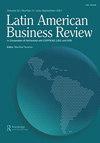Trading Imbalance, Liquidity and Stock Returns: Evidence from Brazil
IF 0.7
Q3 Business, Management and Accounting
引用次数: 3
Abstract
Abstract The present study investigates empirically whether trading imbalances affect cross-sectional stock returns in the Brazilian market. This question is particularly important in emerging markets, where there is strong evidence that order flows of institutional investors are persistent. The main contribution of this study is to price the effect of intraday imbalances through a variable that we call TIP (Trading Imbalance Picture) in an asset pricing regression. The analysis is carried out considering variations for enhanced corporate governance listing segments, economic sectors, and risk factors. The results suggest that trading imbalance strongly predicts stock returns in the cross-section, even after accounting for risk factors, firm characteristics and other liquidity measures, and a daily difference of 1% in TIP among stocks translates into a difference in required return of 6.96% per year.贸易失衡、流动性与股票收益:来自巴西的证据
摘要本文对交易失衡是否影响巴西市场横截面股票收益进行实证研究。这个问题在新兴市场尤为重要,有强有力的证据表明,机构投资者的订单流持续存在。本研究的主要贡献是通过资产定价回归中我们称之为TIP(交易失衡图)的变量对日内失衡的影响进行定价。该分析考虑了公司治理增强、上市部门、经济部门和风险因素的变化。结果表明,即使在考虑了风险因素、公司特征和其他流动性指标后,交易不平衡在横截面上也能强烈预测股票的回报,股票之间TIP的日差异为1%,则意味着每年所需回报的差异为6.96%。
本文章由计算机程序翻译,如有差异,请以英文原文为准。
求助全文
约1分钟内获得全文
求助全文
来源期刊

Latin American Business Review
Business, Management and Accounting-Business and International Management
CiteScore
2.40
自引率
0.00%
发文量
6
期刊介绍:
Latin American Business Review is a quarterly, refereed journal which facilitates the exchange of information and new ideas between academics, business practitioners, public policymakers, and those in the international development community. Special features of the journal will keep you current on various teaching, research, and information sources. These activities all focus on the business and economic environment of the diverse and dynamic countries of the Americas.
 求助内容:
求助内容: 应助结果提醒方式:
应助结果提醒方式:


